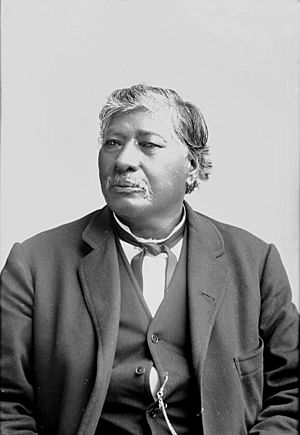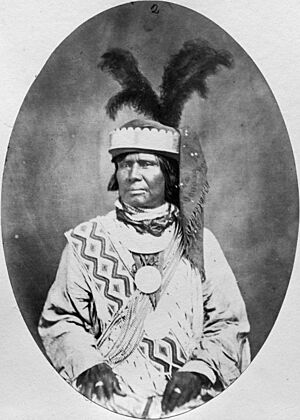Seminole in the American Civil War facts for kids
During the American Civil War, the Seminole people were involved in fighting in different parts of the country. Some Seminoles lived west of the Mississippi River, in what was then called the Indian Territory (modern-day Oklahoma). Others lived in Florida. The Seminole Nation in the Indian Territory was divided. Most of them joined the Union Army, led by Billy Bowlegs. However, some, like John Jumper, supported the Confederacy. The Seminoles in Florida also took part in some small battles, especially in central Florida. They might have been at the Battle of Olustee in February 1864.
Contents
Seminoles West of the Mississippi River

In 1884, a newspaper called The Philadelphia Inquirer reported that most Seminoles supported the Union. They lived near other tribes like the Choctaws, Chickasaws, Cherokees, and Creeks. These neighboring tribes mostly joined the Confederacy. Because of this, it was not safe for the Seminoles to stay in the Indian Territory.
Many Seminoles decided to move south towards the U.S.-Mexican border. On their journey, a Confederate army group attacked them. Their main leader, Billy Bowlegs, was killed. The remaining Seminoles crossed into Mexico and stayed there until the Civil War ended.
The Seminole Nation members who did not move to Mexico were led by John Jumper. His Seminole name was "Hemha Micco." He became a major, then a lieutenant colonel, and finally a colonel in the Confederate army. He fought in several battles, including Round Mountain, Chusto-Talasah, Middle Boggy, and Second Cabin Creek.
Seminole Military Groups
The Seminole Nation organized its fighters into different groups. These groups were called companies, battalions, and regiments.
First Seminole Battalion
The First Seminole Battalion was formed on September 21, 1861.
- Leaders: Major John Jumper
- Companies:
- Company A (Captain George Cloud)
- Company B (Captain Fushatchie Cochokna)
First Seminole Regiment
The First Seminole Battalion later became the 1st Seminole Regiment on July 1, 1864.
- Leaders: Colonel John Jumper, Major George Cloud
- Other Officers: Charles C. Dyer, D. R. Patterson, W. W. Burnes, Hu McDonald
- Companies:
- Company A (Captain Thomas Cloud)
- Company B (Captain Fushatchie Cochokna)
- Company C (Captain James Factor)
- Company D (Captain Tustanucogee)
- Company E (Captain Sam Hill)
- Company F (Captain Osuchee Harjo)
Seminoles in Florida
In Florida, two special companies were formed that included Seminole Indians fighting for the Confederate Army. Andrew E. Hodges, a white man who lived near Cedar Key, started one of these companies in 1862. His company was made up of skilled shooters, including Seminole Indians, white settlers, Hispanic people, Black individuals, and members of other tribes.
Seminoles might have served as sharp shooters (expert marksmen) at the Battle of Olustee. By July 1864, Hodges handed over his company to Andrew M. McBride. McBride became the captain and wrote to the Secretary of War, James A. Seddon, saying the company was ready to fight.
"The Florida Indians, November 5, 1862"
—The Weekly Advertiser
Hodges' Company
When the Civil War began, Andrew E. Hodges lived near Cedar Key, Florida. In 1862, he was part of a local defense group that patrolled the coasts and waterways. Later that year, he formed his company of sharp shooters.
McBride's Company
McBride gathered 65 individuals on July 7, 1864, in Everglades, Florida. They signed up to volunteer their services to the Confederate States of America. They chose A. McBride as their Captain.
Florida Seminole Military Groups
- Hodges' Company (active from 1862 to July 1864)
- Led by Andrew E. Hodges
- McBride's Company (active from July 1864 to 1865)
- Led by Captain Andrew M. McBride
- Total: 65 men
Battles in Florida
"The most desperate enemy that we have to contend with here is the Florida Indians, who have organized themselves into roving bands of bushwhackers and occasionally steal upon our picket lines under cover of night and disturb our sentinels. Many of the Redskins are sharp-shooters. During the recent battle, they betook themselves to the tree-tops and picked off many of the officers of the Colored Troops."
—Frederick F. French
After the War
West of the Mississippi River
After the war, the period known as Reconstruction was very difficult for the Native American nations living west of the Mississippi.
Florida Seminoles
After the war ended, the Seminole Indians in Florida became more private. Their history from this time became less known. Florida's Seminole Indians continue to live in and around the Everglades today.
Both Andrew E. Hodges and Andrew M. McBride survived the war. They lived the rest of their lives in Florida.


